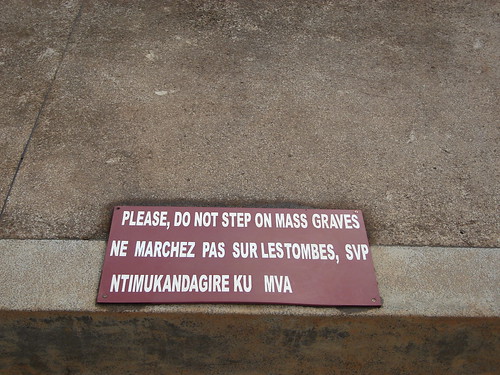Gorillas, Genocide Part II
On our last day in Rwanda, here I was, sitting by the pool at the Milles des Collines, or Hotel Rwanda. SMP had to have a Coke before she passed out and we sat at the bar and talked about the movie where people taking refuge from the genocide were taking water out of this same pool because the supply had been cut off. It seemed impossible that this could have happened a mere 14 years ago.
Two days before, we had been taken to the genocide museum by our guide, Patrick. I am not sure why I have a penchant for sites of mass murder—Dachau, SI-21, gulags—but these in these places I am always overwhelmed with guilt and a sense of responsibility.

By way of a little background—I am not sure if anyone really remembers how it all happened but I will try to provide a recap so that this whole entry is contextualized (forgive me for historical inaccuracies):
Apparently Hutus and Tutsis have been ethnic groups in the area now known as Rwanda for a long time. In the 1930s, Belgian colonists issued identification cards marking the ethnicity of the two groups which had not been an issue before. (I am a little fuzzy on this point; the museum exhibit reported the demarcation of Hutu or Tutsi to be based on assets [Tutsis had more than 10 cattle and Hutus fewer]. The internets say that these ethnic divisions have been around for centuries, while others have said it was based on facial characteristics and skin tone.) For a long time prior to the issuance of these cards, Tutsis had been the ruling minority; with the Belgian control of the country, Tutsis again were given privilege over their Hutu country(wo)men. For the next few decades, Tutsis were given government jobs and allowed educational opportunities denied Hutus. As the colonists moved out, the problems started.
In the 1960s and 1970s there were isolated “trial runs” for the genocide with Hutus murdering Tutsi villages and Tutsis seeking revenge. As time went on, animosity between the groups grew. In early 1994, a UN informant told the organization that weapons were being stockpiled for genocide and that groups were being trained “to kill 1,000 people every 20 minutes”. In fact, there was a militia of over 30,000 trained when the killing started. The French government had supplied the Hutus with $12 million worth of weapons “on loan”.
No action was taken on the news provided by the informant.
Long story short, the Rwandan President’s plane was shot down on April 6, also killing the Hutu president of Burundi. The Prime Minister was set to give a speech to the country the next day, but she and ten Belgian soldiers protecting her were murdered before she could speak (this is one of the reasons the UN failed to act—for fear that they would also be targeted). The genocide started almost immediately, fueled by radio broadcasts.
One million people were killed in 100 days. At the museum I looked at a chain used to chain two people together and bury them alive. I saw the skulls and the clothes of the victims. I watched videos of churches where people had sought refuge and their pastors had betrayed them—literally hundreds of bodies in the church and the surrounding compound. I read about women raped by HIV positive men. I saw video of five-year-old children with gashes in their heads from machetes. I read about how people would have their Achilles tendons cut so they could not run while they were forced to watch their families bludgeoned to death while they waited their turn to die. I learned that live people were thrown down latrines—dozens of them—and buried alive. I watched the testimony of a woman who, venturing out after her family was killed, witnessed a baby breastfeeding on its dead mother.
The two parts that were the most difficult for me were the sections on the children and the part about Hutus who risked their lives to save their Tutsi neighbors and friends. In the section on children, there were large photos of the victims—babies and small children—with information posted below like:
Name: Jean Phillipe
Age: 5 years
Favorite food: rice with sauce
Best Friend: Daddy
How killed: Shot in the head
Last words: Mommy, where do I run?
In the part on the heroes of the genocide, the Hutus who helped the Tutsis, I read about an old woman who was suspected of being a sorceress who scared the militia away by threatening to curse them. I read about a man who hid several dozen Tutsis in a trench in his yard which he disguised by planting pumpkins on top of the thatched cover. I read about a woman whose house was filled to capacity with all of the Tutsis she could hide, but refused to turn away her neighbor. I think this section moved me the most because these were ordinary people risking their lives to save others. So many people either took part or failed to act but these people took a stand. It was heartening.
After the museum we went outside to look at the mass graves. These victims had no families to claim their bodies and no one knows who these people are since whole families and neighborhoods were wiped out. This was not just one small patch of land; at least seven large concrete slabs (probably 20 feet long by 15 feet wide) containing hundreds of bodies. Each village has its own mass grave.
On the way out of town we saw trucks with men in pink uniforms on the back. These were the men who committed the genocide being transported to another jail.
Everyone wonders how shit like this can go down without anyone taking action. Guess what? THIS SHIT IS HAPPENING NOW. Genocide is happening right now in Darfur and no one is doing anything. When are we going to become the regular people who take a stand? When are we going to become informed about what is happening in the world and stop the rape and murder?


0 Comments
Recommended Comments
There are no comments to display.
Create an account or sign in to comment
You need to be a member in order to leave a comment
Create an account
Sign up for a new account in our community. It's easy!
Register a new accountSign in
Already have an account? Sign in here.
Sign In Now